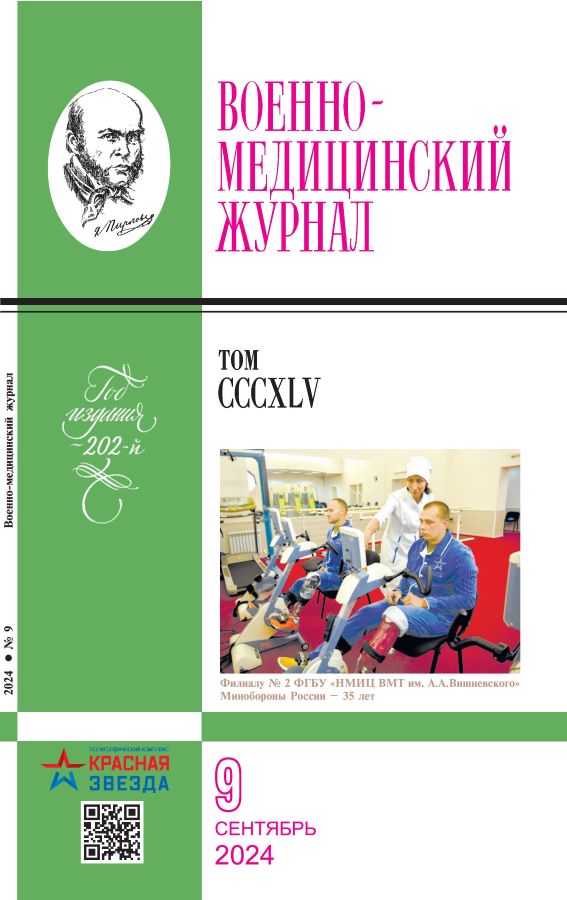Features of providing first aid to injured aircraft crew members in connection with the nature of injuries during ejection
- Authors: Richey I.I.1, Moiseev Y.B.2, Datsko A.V.1, Vovkodav V.S.1, Cherkashin V.S.1
-
Affiliations:
- Main Center for Military Medical Expertise of the Russian Defense Ministry
- Central Research Institute of the Air Force of the Russian Defense Ministry
- Issue: Vol 345, No 9 (2024)
- Pages: 63-70
- Section: Air and navy medicine
- URL: https://journals.eco-vector.com/0026-9050/article/view/636581
- DOI: https://doi.org/10.52424/00269050_2024_345_9_63
- ID: 636581
Cite item
Abstract
The goal is to assess the organization and provision of medical care to flight personnel after an emergency indication of the aircraft. We analyzed 333 injuries received by 214 crew members during ejection from an aircraft in 1980–2020. Including 106 people (49.5%) received severe injuries, 100 (46.7%) received minor injuries, and another 5 (2.8%) received moderate injuries. A minimum of 34.6% of pilots required first aid. First aid as self- and mutual aid was provided to only 7.7% of injured crew members; 37.5% of ejected crew members received first aid from search and rescue groups, which included medical workers. A fairly rapid evacuation from the accident site was noted: half of the crews were delivered to the airfield less than 2 hours after the ejection. To increase the efficiency of first aid, it is advisable to equip the flight crew with modern effective non-narcotic painkillers and hemostatic agents, including tourniquets or tourniquets, by additionally equipping a portable emergency supply of the medical group or by providing compact portable first aid kits with the minimum necessary medical equipment.
Full Text
About the authors
I. I. Richey
Main Center for Military Medical Expertise of the Russian Defense Ministry
Email: cnii_vvs_niic_msk@mil.ru
подполковник медицинской службы
Russian Federation, MoscowYu. B. Moiseev
Central Research Institute of the Air Force of the Russian Defense Ministry
Author for correspondence.
Email: cnii_vvs_niic_msk@mil.ru
профессор, полковник медицинской службы в отставке
Russian Federation, MoscowA. V. Datsko
Main Center for Military Medical Expertise of the Russian Defense Ministry
Email: cnii_vvs_niic_msk@mil.ru
полковник медицинской службы
Russian Federation, MoscowV. S. Vovkodav
Main Center for Military Medical Expertise of the Russian Defense Ministry
Email: cnii_vvs_niic_msk@mil.ru
полковник медицинской службы
Russian Federation, MoscowV. S. Cherkashin
Main Center for Military Medical Expertise of the Russian Defense Ministry
Email: cnii_vvs_niic_msk@mil.ru
подполковник медицинской службы
Russian Federation, MoscowReferences
- Моисеев Ю.Б., Лозбин А.С., Страхов А.Ю. Классификация влияния последствий катапультирования на профессиональное здоровье летного состава // Воен.-мед. журн. – 2011. – Т. 332, № 5. – С. 49–53.
- Озерецковский Л.Б., Гуманенко Е.К., Бояринцев В.В. Раневая баллистика. – СПб: Журн. «Калашников», 2006. – 373 с.
- Первая помощь // Большая советская энциклопедия. – 3-е изд. – М.: Советская энциклопедия, 1982. – Т. 18. – С. 474–475.
- Приказ министра обороны РФ № 455 от 09.10.1999 г. «Об утверждении Положения о медицинском освидетельствовании летного состава авиации Вооруженных Сил Российской Федерации».
- Ричей И.И., Моисеев Ю.Б., Дацко А.В. Некоторые особенности оказания первой медицинской помощи летчикам после катапультирования / Профессиональное здоровье военнослужащих. Сб. матер. Всеарм. науч.-практ. конф. (к 100-лет. со дня рожд. проф. И.Д.Кудрина). – СПб: ВМедА им. С.М.Кирова, 2023. – С. 216–219.
- Самопомощь и взаимопомощь // Большая медицинская энциклопедия. – 3-е изд. – М.: Советская энциклопедия, 1984. – Т. 22. – С. 463–464.
- Шкала оценки тяжести повреждений AIS/ISS. Травма грудной клетки (одобрено Минздравом России). Приложение Г1 [Электронный ресурс]. Режим доступа: https:// www.consultant.ru>cons_doc_LAW_411661 (дата обращения: 22.01. 2024).
Supplementary files










